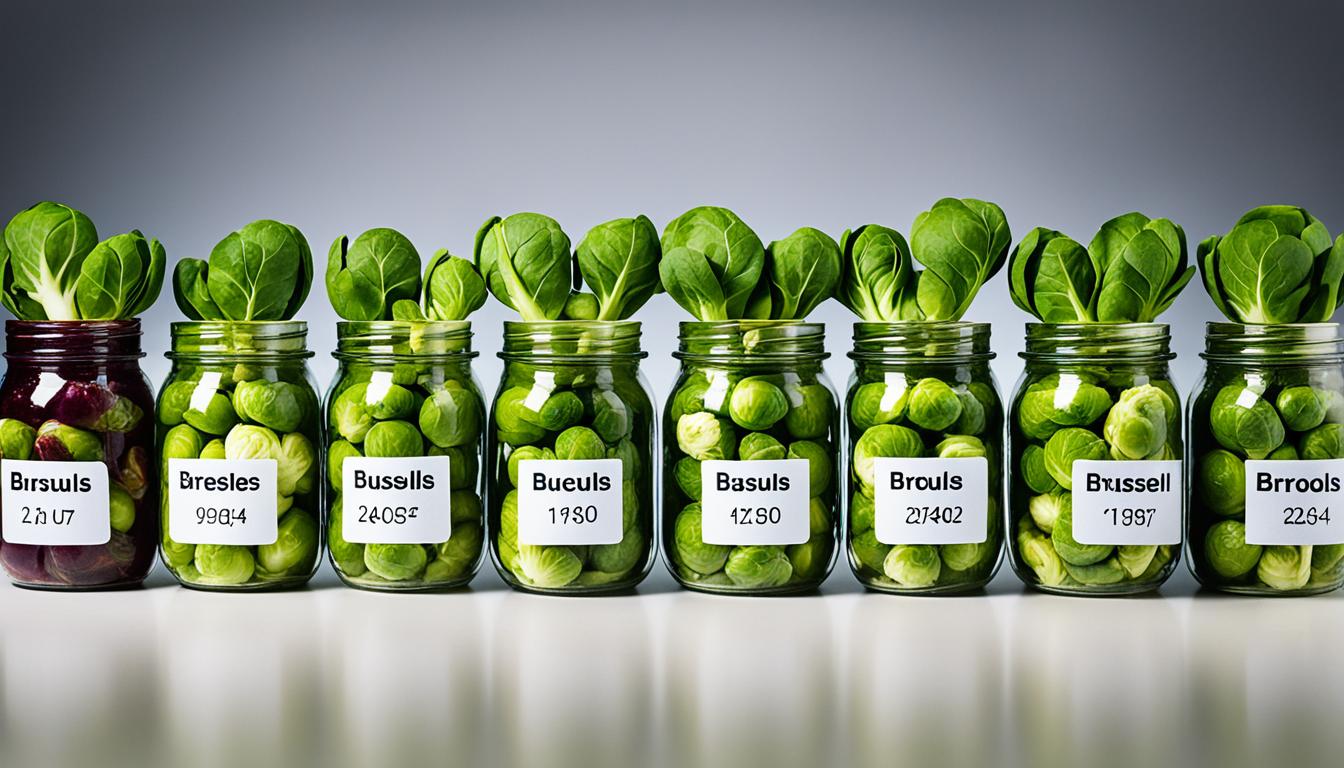Brussels sprouts are both nutritious and versatile. You can enjoy them in many dishes. Knowing how to store them and their shelf life keeps their flavor and nutrition.
Wondering how long brussel sprouts last? In the fridge, they stay fresh for up to a week. But, they taste best if eaten within 3-4 days after buying.
For the longest freshness, place unwashed brussels sprouts in a plastic bag. Keep them in the fridge’s crisper drawer. Don’t wash them until you’re about to use them.
Key Takeaways:
- Brussels sprouts can last up to a week in the refrigerator.
- Their taste becomes stronger and less sweet over time.
- Store fresh, unwashed brussels sprouts in a plastic bag in the crisper drawer.
- Avoid washing them until you’re ready to use them.
- Enjoy them within 3-4 days of purchase for the best flavor.
Storing Brussels Sprouts
Storing Brussels sprouts properly can make them last longer and stay fresh. Here are simple tips to help you:
Keeping them on the Stalk
One good method is to keep them on their stalk. This way, the sprouts stay moist and fresh for a more extended time.
Trimming and Airtight Containers
If you trim the Brussels sprouts, keep them in an airtight container. Then, put them in the fridge. They will stay fresh for up to 1-2 days.
Loose Brussels Sprouts
For loose Brussels sprouts, check and remove any that are damaged. Then, put the good ones back in their original pack or a plastic bag. This keeps them fresh longer.
By using these tips, your Brussels sprouts will stay fresh. Then, you can enjoy them in your meals anytime!
| Storage Method | Shelf Life |
|---|---|
| On the stalk | Up to 2 weeks |
| Trimmed and stored in an airtight container | 1-2 days |
| Loose Brussels sprouts in original packaging or a plastic bag | Up to 1 week |
Preserving Brussels Sprouts
Freezing Brussels sprouts is a great way to keep them fresh longer. This method keeps their quality high and lets you have them all year. It’s key to follow the right steps when preserving them.
Blanching for Quality
Blanching Brussels sprouts before you freeze them is important. It keeps their texture, color, and taste good. This means boiling them briefly, then cooling them fast.
Blanching makes sure they stay tasty and full of nutrients.
Blanching locks in the freshness and quality of Brussels sprouts. It’s a simple but important step for the best taste and texture.
The Freezing Process
Let the Brussels sprouts cool after blanching. This stops water from forming ice inside, which ruins their quality. Then, put them in sealed containers or bags. Press out all the air to prevent damage in the freezer.
Properly frozen Brussels sprouts stay good for a year. It’s all about how you pack them and keep them cold.
A Note on Freshness
Freshness matters a lot for frozen Brussels sprouts. The newer they are when frozen, the better they taste. Always choose the freshest ones for the best taste in your meals.
For the best results when freezing Brussels sprouts, start with the freshest ones you can find.
In Summary
To keep Brussels sprouts fresh, freeze them. Start by blanching to keep their freshness and taste. Then cool them well before packing in air-tight containers or bags. If done right, they can last up to a year. Remember, fresher sprouts taste better.
Recognizing Spoilage
It’s crucial for both food safety and taste to know when Brussels sprouts go bad. Using the right storage methods can keep them fresh longer. Yet, knowing when they’ve spoiled and tossing them out is essential.
Here’s how to tell if Brussels sprouts are bad:
- Yellowing leaves: They should be bright green. Yellow or discolored leaves mean they’re getting old and going bad.
- Brown spots: Dark spots on sprouts show spoilage. This could be because of fungus or bacteria.
- Soft texture: They need to be firm. If they’re soft or mushy, they’ve spoiled.
Look closely at Brussels sprouts’ appearance, feel, and smell to judge their quality. Mold or a nasty smell means you should throw them away right away.
“Fresh Brussels sprouts should have vibrant green leaves. If you notice any yellowing or discoloration, it’s a sign of aging and deterioration.”
Eating Brussels sprouts at their freshest means better taste and more nutrients. Make sure to store them properly and use them before they go bad.
| Signs of Brussel Sprouts Spoilage | Causes |
|---|---|
| Yellowing leaves | Aging and deterioration |
| Brown spots | Fungal growth or bacterial activity |
| Soft texture | Spoilage or decay |
Selection and Preparation
Choosing brussel sprouts is easy once you know what to look for. Find sprouts that are bright green. This shows they’re fresh. Make sure they have leaves that are close together and feel firm. This means they’re good quality.
Avoid sprouts with yellow or damaged leaves. They might be old or spoiled. Once you pick your brussel sprouts, getting them ready is key for the best taste. Start by taking off any leaves that are yellowed or damaged. This keeps only the fresh ones.
Wash them well under cold water to get rid of dirt. Then, cut off the bottom stem of each brussel sprout. These stems are tough and not nice to eat. Also, throw away any leaves that look bad.
With these steps, your brussel sprouts will be perfect to cook and enjoy.
Selection and Preparation Tips:
- Choose brussel sprouts with vibrant green color, tightly packed leaves, and a firm texture.
- Remove any yellowed or damaged outer leaves.
- Rinse the sprouts under cold running water to remove dirt and debris.
- Trim off the bottom stem of each sprout and discard any discolored outer leaves.
Expert Quote:
“Proper selection and preparation of brussel sprouts are essential to bring out their full flavor and ensure a delightful dining experience.” – Chef Rachel Johnson
Now, you’re ready for the next steps. We’ll look at how to cook and serve brussel sprouts. These tips will help you make the most of this versatile veggie.
Cooking and Serving Suggestions
There are so many ways to cook Brussels sprouts. You can roast, steam, fry, or braise them. Each method brings out their unique flavors and textures.
Try adding crispy bacon or tangy cheese to cooked Brussels sprouts. These add richness or a burst of taste. The sweet flavor of Brussels sprouts mixed with these ingredients will impress anyone.
Don’t just stick to the usual cooking ways! Use Brussels sprouts in salads for a fresh crunch. Shred them and mix with colorful veggies and a zesty dressing for a refreshing side dish.
Be creative with your seasonings and spices. Experiment with garlic, thyme, or paprika. Finding your favorite flavors can make Brussels sprouts even more delicious.
“The versatility of Brussels sprouts allows you to create endless culinary delights. From classic roasted sprouts with a touch of balsamic glaze to flavorful stir-fried sprouts with garlic and soy sauce, let your creativity soar in the kitchen.” – Chef Emily Roberts
Brussels Sprouts Cooking Ideas
Need kitchen inspiration? Here are popular ways to cook Brussels sprouts:
- Roasted Brussels Sprouts with Balsamic Glaze and Parmesan
- Steamed Brussels Sprouts with Lemon Butter Sauce
- Stir-Fried Brussels Sprouts with Garlic and Soy Sauce
- Braised Brussels Sprouts with Bacon and Maple Syrup
- Grilled Brussels Sprouts Skewers with Honey Mustard Marinade
Always adjust cooking times and temperatures for the perfect tenderness and flavor. Enjoy finding the best way to cook Brussels sprouts that you love.
Brussels sprouts can be a great addition to any meal. Whether as a side or the main dish, different cooking methods and ingredients will impress your guests and boost your kitchen skills.
Health Benefits of Brussels Sprouts
Brussels sprouts belong to the cruciferous vegetable family. They are known for their possible health benefits. This includes effects against cancer.
These veggies have glucosinolates, compounds that contain sulfur. When these compounds break down, they release isothiocyanates. Research has looked into their role in protecting against DNA damage and stopping tumors from growing.
“Cruciferous vegetables like Brussels sprouts contain compounds that have shown potential for reducing the risk of certain cancers.”
But, it’s important to understand that direct proof linking Brussels sprouts to fighting cancer in humans is not yet available. Eating a variety of cruciferous vegetables is the best way to enjoy their health perks.
Adding Brussels sprouts to your diet is a smart move. With their unique nutrients and health benefits, they’re great for your meals.
Other Potential Health Benefits
Brussels sprouts have other benefits too:
- Rich in vitamins C and K: They boost your immune system and support bone health.
- High in fiber: This helps with digestion and keeping a healthy digestive system.
- Antioxidant properties: Brussels sprouts help protect your cells from free radical damage.
- Supports heart health: Their fiber, potassium, and antioxidants help prevent high blood pressure and keep cholesterol in check.
Adding Brussels sprouts to your meals can be tasty. Try them roasted with garlic and olive oil or in a salad.
Try cooking them in different ways. Use various seasonings to find how you like them best.
Selecting Fresh Brussels Sprouts
Choosing fresh Brussels sprouts is easy if you know what to look for. Paying attention to their look and feel can ensure they taste great. Here’s how to pick the best Brussels sprouts.
Look for Visual Clues
First, check the color. Bright green sprouts are what you want. They shouldn’t have yellow or wilted leaves.
Leaves that are close together show they’re fresh. Stay away from sprouts with yellow or wilted leaves. They’re not fresh.
Check the Texture
Texture is key too. Give the sprouts a gentle squeeze. They should be firm, not soft or squishy.
Soft or squishy sprouts might be going bad. It’s best to avoid them.
Did you know? Brussels sprouts can be kept fresh for 3-5 weeks at freezing temperatures or 1-2 weeks when refrigerated. Longer storage may result in discoloration, black spots, wilting, and decay.
Inspect for Quality
Take a good look at each sprout. Make sure there’s no damage or signs of decay. Throw away any with black spots, browning, or a bad smell.
Choosing good quality sprouts makes your meals better. You’ll enjoy cooking and eating them more.
Follow these tips for the freshest Brussels sprouts. Look for bright color, firm texture, and tightly packed leaves. Fresh sprouts will make your dishes tastier and healthier.
Proper Preparation Techniques
Before preparing brussel sprouts for cooking, make sure to rinse them under cool water. This gets rid of dirt. After rinsing, trim off the tough stems at the bottom. And throw away any discolored or damaged leaves.
Once your Brussels sprouts are clean and trimmed, you can cook them in different ways. You can roast, steam, or even shave them. Each method brings out unique flavors and textures.
Roasting Brussels sprouts:
To roast, first preheat your oven to 400°F (200°C). Coat the sprouts in olive oil, add salt and pepper, and put them on a baking sheet. Bake them for 25-30 minutes. They should be tender and slightly browned when done.
Steaming Brussels sprouts:
Steaming is a healthy way to cook Brussels sprouts. It keeps their nutrients. Just boil an inch of water in a pot. Put the sprouts in a steamer basket, cover, and steam for 6-8 minutes. They should be tender but still green.
Shaving Brussels sprouts:
Shaving Brussels sprouts lets you use them raw or cooked. Cut the sprouts in half and remove the core. Then, thinly slice them. You can eat shaved Brussels sprouts raw in salads or sauté them quickly.
Each cooking method has its own special taste and texture. You might like the sweet taste of roasted Brussels sprouts or the softness of steamed ones. Trying different methods helps you find your favorite.
Choosing how to cook your Brussels sprouts is all about what you enjoy. Don’t hesitate to experiment with different ways to find what tastes and textures you like the most!
Now you know how to prepare Brussels sprouts well. So, start cooking and discover how tasty these versatile veggies can be.
| Cooking Method | Key Features | Best For |
|---|---|---|
| Roasting | Caramelized flavor, crispy texture | Enhancing sweetness, side dish, roasting with other vegetables |
| Steaming | Tender texture, preserves nutrients | Health-conscious individuals, retaining vibrant green color |
| Shaving | Delicate, raw or lightly cooked texture | Salads, quick sautés, adding crunch to dishes |
Tips for Advanced Storage
To keep Brussels sprouts fresh and tasty for a long time, here are some smart storage tips. These tips will make sure your Brussels sprouts remain in their best condition. They’ll be fresh and yummy for longer.
Storing on the Stalk
One good way to keep Brussels sprouts fresh is to store them on their stalk. The stalk feeds the sprouts and keeps them moist. This keeps them crispy and full of flavor. Just wrap the stalk in a damp paper towel and put it in your fridge. This trick can add days to the shelf life of your Brussels sprouts.
Blanching and Freezing
For longer storage, try blanching and freezing your Brussels sprouts. Blanching means you boil them briefly and then cool them quickly in ice water. This stops the enzymes that cause them to spoil. After blanching, freeze the sprouts in a tight container or freezer bag. They can last up to a year. Though they may feel different, frozen sprouts are still great for cooking and recipes.
Proper Storage Conditions
To store Brussels sprouts right, aside from the above methods, follow these additional tips:
- Keep them cool, between 32°F and 40°F.
- Don’t let them near fruits like apples, bananas, and tomatoes that produce ethylene. It can make them go bad faster.
- Put the sprouts in airtight containers or sealed bags to keep them from drying out.
- Regularly check for bad ones and throw out any that look moldy, slimy, or smell bad.
Conclusion
Understanding how to store Brussels sprouts can make them last longer and taste better. They can stay fresh for a week in the fridge. Yet, their flavor starts to weaken with time. To keep them fresh, place them in your fridge’s crisper drawer. It’s also a good idea to leave them on their stalk until you use them.
For keeping Brussels sprouts longer, freezing is a good choice. But remember, freezing can change their taste. It’s best to freeze sprouts that are fresh from the harvest for the best flavor. Be sure to watch for signs of spoilage like yellow leaves, brown spots, and softness. This helps keep your food safe and delicious.
To get the most out of Brussels sprouts, prepare them well. Wash, trim, and cook them using methods like roasting, steaming, frying, or braising. These methods make Brussels sprouts a tasty addition to many meals. Don’t forget to try different spices and ingredients to find the flavors you like best with Brussels sprouts.





